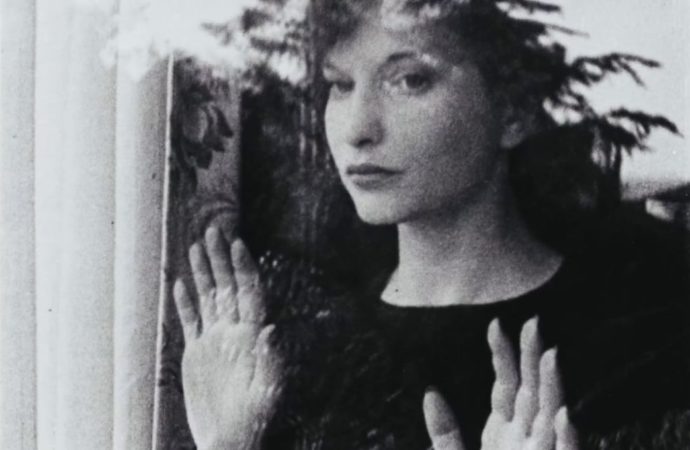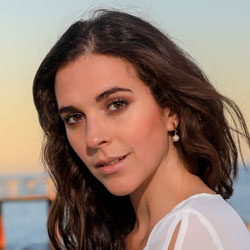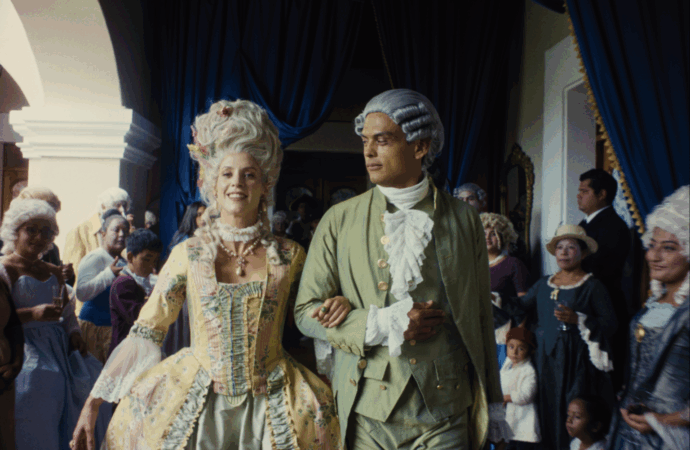Carolina Martínez is a lecturer and researcher at the Escola Universitària de les Arts (ERAM) of the University of Girona and one of the leading experts on the work of Maya Deren, pioneer of experimental cinema and mother of the American avant-garde. She will visit València on Monday, 30 September, to take part in the first tribute paid in the city to the Ukrainian filmmaker, which will be held with free admission (19:00) in the Aula Magna of the historic building of the University of Valencia (c/ Universitat 2) thanks to the initiative of the Aula de Cinema UV directed by Professor Manuel de la Fuente, through the Vice-Rectorate for Culture and Society.
Like Maya Deren, Carolina Martínez is multifaceted: poet, dancer, writer, researcher, teacher, film buff… A tireless worker, she combines her teaching and university activities with other cultural commitments: she is a member of the selection committee of the Valladolid International Film Week (SEMINCI), which she also coordinates and presents; she is an actress with training in theatre and dance; she is a stage and film manager with the coordination of the Cuenca Spanish Film Week and the production management of the International Film Festival Women in Direction; and poet and co-founder, together with the designer Cristina Vergara, of the artistic-literary project Salvoconducto books, where she has published the poetry books escribir y respirar (2020) and el punto ciego del paisaje (2021).

Editor, anthologist and translator of El universo dereniano. Textos fundamentales de la cineasta Maya Deren (UCLM and ARTEA 2015 and 2020), will take part in the panel discussion in Valencia together with Christine Cloux, dancer and choreographer and winner of the Max Award 2024, and the composer Isabel Latorre, in an event that will include the screening of the short films made by Deren in the 1940s: At Land, Meditation on Violence, Ritual in Transfigured Time, A Study in Choreography for Camera and Meshes of the Afternoon (awarded at the Cannes Film Festival in 1947). Witch’s Cradle, a film in which Marcel Duchamp participated, will round off the tribute and will be offered with live music by Isabel Latorre and Eva Amado. We have talked to Carolina Martínez, to give us an insight into the unique personality of the Ukrainian artist.
CLAUDIA MORAS: Who was Maya Deren?
CAROLINA MARTÍNEZ: Maya Deren was, and still is, a fascinating character who was born in Kiev in 1917 and died in New York in 1961. I give these dates because it is important to place her in her time. She was many things: a political activist, she was passionate about writing poetry, dance and photography, but what served as a catalyst for all this was film, which she entered in a practically self-taught way. And why is it important for us today? Well, Jonas Mekas always said that Deren was the mother of them all, of all those who formed the American avant-garde movement. They started making films a few years after Maya Deren and they always considered her the mother of the movement, although she often doesn’t appear as one of its names; and she is also the mother of what the art critic John Martin once called, in reference to one of her films, choreocinema or choreocinema, that is to say, the germ of today’s video-dance.

Maya Deren.
A multifaceted artist…, but what aspects of her work will be addressed at the Universitat de València?
Above all, we are going to focus on the principles he developed in each of his films, where the idea of ritual is also very present, hence the name of the day, and ritual understood in an expanded way, we could say, in terms of the connection between form and content when making a work of art, which is present from the beginning in his films, as is movement and dance, hence the presence of Christine Cloux. Deren, from her first film, Meshes of the Afternoon (1943), which made her the first woman to win a prize at the Cannes Film Festival, presents aspects that lead us to intuit what is to come later: her desire to choreograph everything that was on the other side of the lens and also everything that was behind the lens, because in the end there is a dance between herself, the camera and everything that is on the other side until the post-production process of editing is completed. She had an integrating vision of the world, in fact her writings prove it: how she connected everything, the scientific advances of her time with what was happening in the cinematographic medium…
Deren is a pioneer of experimental cinema and the mother of the avant-garde in the United States, but she is also unknown to the general public, why?
Maya Deren’s case is that of many women artists, such as Agnès Varda in the Nouvelle vague, a clear parallel of Maya Deren in Europe, or Mary Ellen Bute, Shirley Clarke…, who were left in the shadow of their male counterparts. There is a double edge here, isn’t there? On the one hand, women allowed certain artistic and avant-garde movements to be advanced by working on the margins and nothing was expected of them; they were not at the service of the commercial sector or had large budgets, which allowed them creative freedom; But this marginality, while opening the way for new movements, later leaves them in the shadows because of the tendency that has existed to leave women aside, to make them invisible, because the history of cinema is full of names from its beginnings, such as Ida Lupino and others, who were left in a secondary role when cinema became a big industry. It happens that women go ahead with movements, and once they are consolidated, they are left in the shadows again and it is the men who appear at the forefront, it is the men’s names that are left on the lists when we look for information.
On the other hand, Stan Brakhage, who was a filmmaker of the American avant-garde movement and a close friend of theirs, also said that because Deren was fascinated by the Haitian religion, with everything to do with ritual, with dance (he said he was possessed by the Haitian goddess of love), his last media appearances, both on radio and television, were related to the world of voodoo, a misunderstood voodoo, and this somehow obscured his figure.
How can this injustice be redeemed through education, universities, culture…?
There is a lot of work to be done, but the first thing to do is to teach them in the subjects. It is true that the issue of quotas can be conflictive: including women in the subjects in a forced way, when they should be integrated directly into the subjects, but for this we also need people who are dedicated to rescuing and researching these figures and disseminating them.
Maya Deren did not like her films to be labelled surrealist, nor did she like to be labelled as such.
Deren, who died at the age of 44, was opposed to commercialism and the yoke of the big film industry. What do you think would have happened if he had enjoyed a longer life? Would he have jumped on the Hollywood bandwagon, for example?
I don’t think it would have changed, as it has with other similar figures like Shirley Clarke, but I don’t know. Deren was a tireless worker, fascinated by everything she did. It is said that what killed her was a kind of cerebral infarction due to the abuse of amphetamines at that time, of substances of this type that many artists used, not just her, because of her obsession with work, with writing… Her case is very interesting because at the same time as she was making the films, she was writing texts in which she was explaining what she was doing with the cinematographic mechanism; because she was dedicated to exploring the capacities of the medium to the maximum, above all in the process of making and post-production. So, I think it would have been difficult to maintain that intensity over time, and his life was like a star that shone with a very powerful light for as long as it shone until it burned out, wasn’t it? I think that every life has its beginning and its end as a closed structure and in Maya Deren that structure is very clear, it’s like her filmic corpus is also very complete and very coherent.
Your thesis investigates the Derenian universe, what led you to it?
Like most people, I didn’t know Maya Deren either. It was 2005 and I was doing my doctorate at the Faculty of Fine Arts in Cuenca. There we had a course on Documentary Film and my professor, Ignacio Oliva, invited Moira Sullivan, a professor at the University of San Francisco, author of the prologue to the book El universo dereniano and the first in the world to write a thesis on Deren. Thanks to them, the door was opened to Maya Deren at the Faculty at a time when, as we said, hardly anyone knew her. I was looking for a topic for my thesis and Ignacio told me why I didn’t do more on Maya Deren, because she combined all the things that interested me: poetry, dance, cinema… And that’s how I was introduced to her.
Would it be interesting to transfer experimentation and surrealism to large audiences and would it not lose its essence?
Here it is necessary to digress because Maya Deren did not like her films to be labelled surrealist or to be labelled with any label, and she was also against a direct or symbolic translation of her films, because she wanted to go further. And secondly, every movement has its own explanation or reason at any given moment. What she was doing was fighting for an amateur cinema, she said, against professional cinema, in the sense of a lover, against the commercial, against the Hollywood industry. Obviously, this is a radical way of thinking, but it is also necessary for other voices and counterparts to appear.

Carolina Martínez.
But how does the genre enrich us if it is only accessible to a cultural elite?
There is a big mistake, and that is to think, as happens with all abstract or experimental art, that this is not real, or that it has nothing to do with us, or that it is only for the elite. I always give my students the example: if we take a mobile phone and start recording the movement from the window of a train, what we are going to have as a result is going to be an abstract film, however, it is the reality that we are seeing. What happens is that we are used to stories being told to us from a logical narrative and in a very literary way, according to the classic Hollywood narrative. And I think it’s wonderful to see art as when we are children, without bias and with a naïve, clean, non-judgmental look at certain aspects, which allows us to return to a kind of uncontaminated perception or to open ourselves to a new perception. In reality, not everything can be explained in words (in fact, not at all!); life is not a cause and effect, it is not an introduction-nude-denouement. In fact, today more than ever we live in a society full of stimuli, fragmentary, fragmented, non-linear. So what experimental cinema seeks to do is to open us up to another kind of relationship with the world, to the intuitive, to the sensory, not simply to a rational reading.
Like Deren, you have an artistic and audiovisual background, you produce, write and act… What do you identify with more: the character or the work?
In Maya Deren everything is always linked, connected, her view of reality and the world, and her work. So I think it’s so coherent how she lived, how she worked, the texts she wrote, the films she made: you can’t separate the character from her work.
As a film expert, how do you define the quality of Valencian cinema?
It is a cinema that is struggling to make headway despite the economic difficulties and is becoming more and more important. It has interesting figures such as Álex Montoya, who is perhaps one of the names most often mentioned by La Casa, and there are also talented people who are currently beginning to emerge, such as Alberto Evangelio and Cristina Fernández. Valencian cinema should have more resources, obviously, but there is talent and a very valuable identity, that’s true.








No one has posted any comments yet. Be the first person!